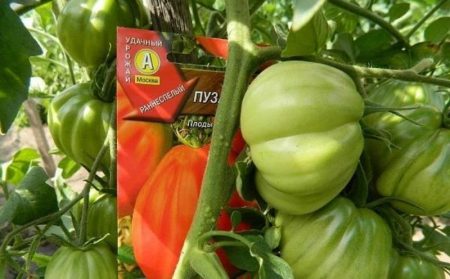 Next to numerous "colleagues", the tomato of the Puzata hut stands out not only by its name. To learn more about it, it is worthwhile to study the detailed characteristics of the variety, view pictures, ask people through forums. This will give a complete picture and help the gardener.
Next to numerous "colleagues", the tomato of the Puzata hut stands out not only by its name. To learn more about it, it is worthwhile to study the detailed characteristics of the variety, view pictures, ask people through forums. This will give a complete picture and help the gardener.
Original tomatoes
Any gardener who harvests annually follows the news of the vegetable market. What kind varieties of tomatoes appeared how to grow them. Selection is constantly evolving, scientists are trying to develop varieties that are most useful to people. For example, a list of factors characterizing a tomato variety:
• Productivity;
• Appearance;
• growing requirements;
• Type of variety (ripening or other);
• Sizes of fruits;
• The average size of mature bushes;
• How well tolerates the disease;
• What is more susceptible;
• Transportation, storage;
• Of course, the taste of the fruit, then the appearance.
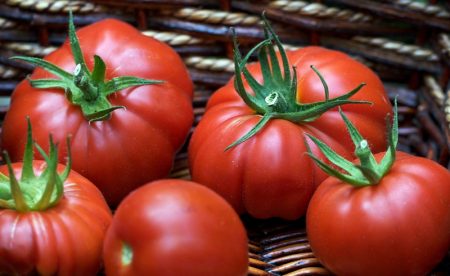
Grade description
Looking through the tomato Puzata hut, reviews and photos, productivity, immediately pay attention to its original appearance. Few varieties of tomatoes are so peculiar, the bulk still has classic shapes - round or oval fruits, in different colors.
The variety can be attributed to early ripening. Moreover, the time must be calculated from the appearance of (mass) planted seedlings to the harvesting period - approximately 87-92 days. This is the first crop. The fruiting period itself in Puzat hut is extended. Most often they prefer to grow it inside greenhouses, but even on open ground, tomatoes take root pretty well. Who planted knows how much the variety is dependent on the region. Most often, only one stem is grown on a bush, but it is permissible when 2 remain.
Important: When caring, you need to remove the stepsons in time. Otherwise, the fruits will begin to grow smaller and the beginning of their bearing will come later than usual.
A plant is considered indeterminate when the bushes do not have an end point for their growth to cease. Usually if planted in open ground, the bushes will grow up to 1.2 m, if in greenhouses - up to 1.7 m, average 1.5 m. But, when the conditions are extremely favorable, they can also be extinct in 2 m. The bush has a moderate foliage, with strong roots, rather weak stems. Therefore, you need to tie up, monitor the wind, if the ground is open. Usually 3-5 individual fruits appear on the hand. Based on the area - 1 sq.m. should occupy 3 bushes, no more.
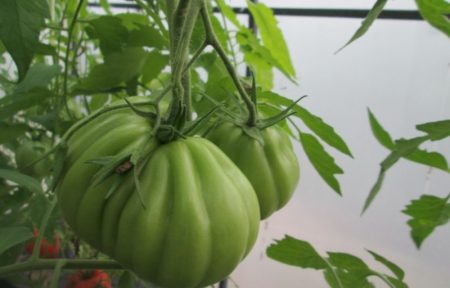
Important: weakish stems of this variety are prone to lodging soon. Therefore, be sure to tie. Especially if the region is famous for winds, heavy rains. You can plant as usual, then use trellises or tall, strong pegs.
Fruit yield
Characterization and description of fruits - Puzata hut are large, with a mass of 300 g these are average indicators. There were times when the fruits grew to 700 g. Ripe tomatoes have a pleasant, muffled red or bright pink color, slightly resembling Beefsteak Tomato. The pulp is tender, tasty and very juicy, few seeds. The skin is dense, usually does not crack. The taste is really pleasant, sweet, but there is a slight sourness. The shape of the fruit is extremely remarkable in the Puzat hut. Tomatoes are somewhat similar to pumpkins, the fruits are ribbed, round or elongated, pear-shaped.
Watching a tomato Puzata hut, reviews often advise eating fresh, shredding in a salad or adding to snacks, hot dishes. Homemade juice is extremely tasty. For canning Puzata hut is also not bad.
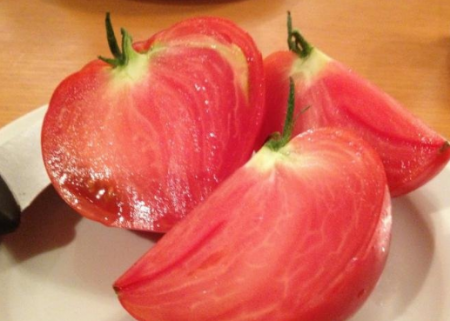
Productivity, which is extremely important for all manufacturers, is high. There are up to 11 kg of large, selected tomatoes, this is 1 sq.m.
Pros, cons of the variety
Of course, a full description of the variety usually includes not only features, pluses, but also cons, so that people can get a complete picture. As a rule, the opinion of connoisseurs helps who has grown these tomatoes for a long time, polished them with beds, tied bushes. Most gardeners emphasize such advantages:
- Good, stable yield - a huge plus for a tomato, rarely which variety promises high yields, most are famous for average rates;
- Resistance to a series of major "tomato" diseases - yes, vegetables also have their own sores, which are extremely unpleasant and sometimes harmful. Crop, plant species, and fruit taste suffer from them;
- Good keeping quality, also the possibility of transportation. Any kind of vegetable or fruit should have a similar plus, because the resulting crop is hardly eaten right away. Stocks are formed, long transportation is possible, especially if large producers grow vegetables. Sometimes the crop is transported for days in bags or crates, then transferred. Keeping quality is crucial. The more% of the crop retains its appearance and taste, the greater the profit.
Fruits are large in size - not everyone may like this, but choosing Puzata hut for growing tomatoes is worth preparing for large, bright and ribbed fruits.
Pleasant taste. There is a lot of sugar in the variety, so sourness is almost not felt. Sometimes it’s nice to eat it simply, fresh as fruit. There are a lot of amino acids in tomatoes, so they are useful for children. Of course, it is unlikely to meet a variety without flaws. Description Puzata hut certainly not replete with accusatory slogans, a few flaws. But there is. The main disadvantages are two:
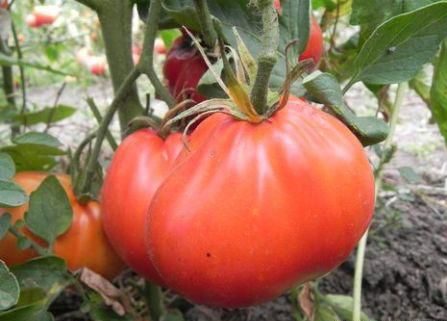
The need to form each bush - however, a similar defect can be attributed to almost 60% or more of the percentage of tomato varieties that grow large. They need to be tied, protected, if necessary, from the wind. Sometimes even medium or low bushes are tied.
The high demands of this plant for various nutrients, as well as for the composition of the soil. Serious minus. There are varieties less demanding on soils, but here you can adjust the composition of the soil by feeding tomatoes with mineral additives. After all, not every gardener can buy another soil or bring it from afar, dig out somewhere in the forest or in the meadow. However, the degree of exactingness of the variety can be clarified with more experienced colleagues who have already grown Puzata hut. Also be sure to ask about the region.
But in general care the variety is unpretentious, grows calmly, does not require jumping around itself for days.
How to grow
Most often they are grown through tomato seedlings. First you need to cook special small pots or portable beds, pour soil there. Sow the seeds around the beginning of March, first having treated with a special growth stimulator. Mix the soil with humus, then the sprouts will receive all the nutrients they need. Sow the seeds in pits 2 cm deep, then place them in a warm, safe place.
As the first sprouts appear, the containers are transported closer to the Light. Watered sparingly, only with warm and soft water. Here came the first pair of real little leaves, so it's time to dive seedlings, then feed them with complex fertilizer.
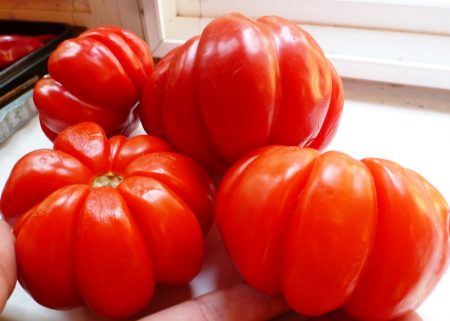
Landing already on open ground or in the greenhouse will be by the 15th day of May or early June. To get on a favorable day, the gardener should check with the lunar calendar. But by May-June, the soil will warm up enough, the days will increase and the whole snow will melt. All the first days of planted plants are better protected with a film. If the soil is protected (greenhouse), tomatoes can be planted earlier, for about 1.5-2 weeks. Places to distribute: 1 sq.m. 3-4 bushes.
Important: after transplantation, formation will begin almost immediately.
It is better to keep the bush on 1 or 2 equal stems, immediately removing the stepsons as soon as the first brush appears. To better bear fruit, it is worth leaving somewhere 7-8 brushes, not more. You can limit the growth of the bush from above, slightly pinching. Tie all tall stems neatly to stakes (trellises) as soon as the fruits begin to ripen. After all, heavier branches will require support.
It is watered only with warm, soft water, loosening the soil in between periods of watering. Add mineral complexes approximately every 1.5-2 weeks (organic fertilizers such as diluted mullein, bird droppings can be used). Non-root top dressing performed by a solution of superphosphate is no less useful.
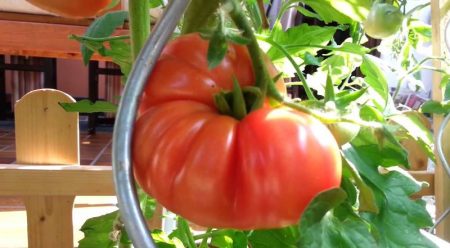
Diseases, pests
The variety is really resistant to disease, but prevention is necessary. Even for greenhouse plants, because greenhouses are not sealed structures with sterile, enclosed conditions. Even before planting, the soil is carefully treated with a solution of potassium permanganate or copper sulfate. As a preventive measure against unpleasant root rot, the same soil can be pre-mulched with straw (humus or peat, which will be at hand).
Important: if there is an epidemic of dangerous late blight, all plantings need to be treated with copper-containing preparations.
Regular inspection of the bushes, spraying with a weak solution of the same potassium permanganate works best against pests. Ordinary soapy water is better for aphids. She needs to wash all the affected areas near the bush. Industrial insecticides should be kept ready if tips or whiteflies appear, as well as spider mites.
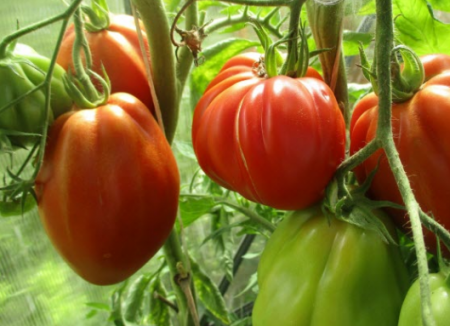
Most gardeners have long considered the Puzata Hut a very promising, interesting variety. They like the shape of the tomato, their taste, high yield. Once planted for experience, they plan to repeat this.
Recommended:Tomato diseases: treatment, signs, photo
Others, on the contrary, note that tomatoes like pears are not very convenient, it is more difficult to preserve them, often hollow, inferior fruits are found. However, it is hollowness that is not a feature of the variety, but the result of uneven watering, which completely depends on the care of the person. If all of the growing tips are implemented correctly, hollow fruits should not occur at all.




 Low-growing tomatoes, without pinching: 5 of the most delicious varieties
Low-growing tomatoes, without pinching: 5 of the most delicious varieties Why tomato seedlings grow poorly
Why tomato seedlings grow poorly We grow a tomato in a shell
We grow a tomato in a shell Growing tomatoes without watering according to the method of Kazarin
Growing tomatoes without watering according to the method of Kazarin